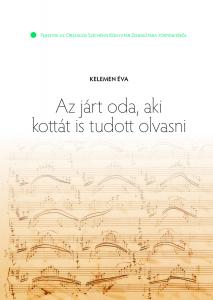
The One Who Could Read Sheet Music Went There
The One Who Could Read Sheet Music Went There
Introductory chapters, interviews and editing by Éva Kelemen
National Széchényi Library, Bp., 2020., 216 pages
ISBN 978-963-200-707-6
The National Library’s collection has treasured musical documents since its founding. Ferenc Széchényi and his family members devoted to music also collected and donated sheet music to the library. During the 19th and 20th centuries, many librarians and library professionals made a point of preserving and enriching musical materials. The idea of creating an independent Music Collection was formed as early as the beginning of the 20th century, and finally in 1924, after lengthy preparations, the Music Department of the library was established.
The editor of the volume, Éva Kelemen, has been studying the history of the nearly hundred-year-old collection for a long time. This time, she used for her research one of the well-known genres of oral history: she collected new data, living memories through personal interviews with former colleagues. The publication of these interviews forms the core of this volume. The edited, engaging conversations bring to life the former everyday life of the Music Collection, and new correlation that written documents could not reveal previously. During the interviews, it also became clear that the certain professional careers intertwined so closely with the private lives of the person and sometimes with the political aspects of the time, that the interviewees’ recollections could raise the interest not only of music and library historians, but also that of a number of cultural history researchers studying the given period, and the general public. All of the interviewees – Mária Eckhardt, Zoltán Falvy, Klára Hamburger, László Somfai and Veronika Vavrinecz – started their careers in the Music Collection of the National Széchényi Library, several of whom became renowned experts of musicology in Hungary and abroad. Mária Eckhardt and Klára Hamburger were renowned representatives of Liszt research, László Somfai was a leading Haydn and Bartók researcher, and Zoltán Falvy, who died shortly after the interview, worked mainly in the field of Hungarian musical records from the Middle Ages. Veronika Vavrinecz, the retired director of the Music Collection, became a renowned specialist in music library science and the exploration of national and international musical sources.
The interviews are introduced by Éva Kelemen’s two earlier studies, the first summarizing a short but rather significant pre-World War II period (1929–1934) of the collection. The second work reports on the years of reconstruction and consolidation after 1945 and the tireless activity of Jenő Vécsey until 1966. The latter is really closely tied to the subjects of the recollections, creating an exciting background to the interviews.
Shopping
Our publications are available in our bookshop, or can be ordered from the Publications Department of the NSZL using the contact details below: Főigazgatói Kabinet kiadványtára, Országos Széchényi Könyvtár, 1276 Budapest P.O. box 1205., phone: 06 1 232-3556, e-mail: kiadvanytar@oszk.hu.




